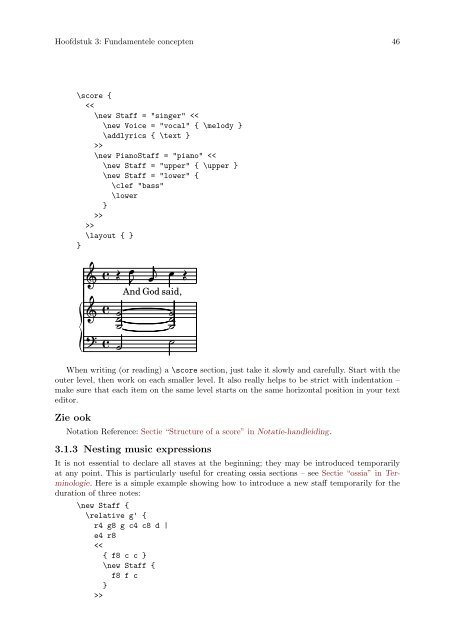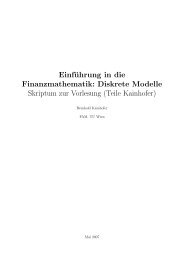- Page 1 and 2: LilyPond Beginnershandleiding Het L
- Page 3 and 4: 3.1.4 On the un-nestedness of brack
- Page 5 and 6: Hoofdstuk 1: Leerboek 1 1 Leerboek
- Page 7 and 8: Hoofdstuk 1: Leerboek 3 Uit de menu
- Page 9 and 10: Hoofdstuk 1: Leerboek 5 Stap 3. Bek
- Page 11 and 12: Hoofdstuk 1: Leerboek 7 Stap 1. Maa
- Page 13 and 14: Hoofdstuk 1: Leerboek 9 Stap 2a. Co
- Page 15 and 16: Hoofdstuk 1: Leerboek 11 Het PDF-be
- Page 17 and 18: Hoofdstuk 1: Leerboek 13 1.1.4 Comm
- Page 19 and 20: Hoofdstuk 1: Leerboek 15 Relatieve
- Page 21 and 22: Hoofdstuk 1: Leerboek 17 4 3
- Page 23 and 24: Hoofdstuk 1: Leerboek 19 • Uitdru
- Page 25 and 26: Hoofdstuk 1: Leerboek 21 • Voorda
- Page 27 and 28: Hoofdstuk 2: Algemene muzieknotatie
- Page 29 and 30: Hoofdstuk 2: Algemene muzieknotatie
- Page 31 and 32: Hoofdstuk 2: Algemene muzieknotatie
- Page 33 and 34: Hoofdstuk 2: Algemene muzieknotatie
- Page 35 and 36: Hoofdstuk 2: Algemene muzieknotatie
- Page 37 and 38: Hoofdstuk 2: Algemene muzieknotatie
- Page 39 and 40: Hoofdstuk 2: Algemene muzieknotatie
- Page 41 and 42: Hoofdstuk 2: Algemene muzieknotatie
- Page 43 and 44: Hoofdstuk 2: Algemene muzieknotatie
- Page 45 and 46: Hoofdstuk 2: Algemene muzieknotatie
- Page 47 and 48: Hoofdstuk 3: Fundamentele concepten
- Page 49: Hoofdstuk 3: Fundamentele concepten
- Page 53 and 54: Hoofdstuk 3: Fundamentele concepten
- Page 55 and 56: Hoofdstuk 3: Fundamentele concepten
- Page 57 and 58: Hoofdstuk 3: Fundamentele concepten
- Page 59 and 60: Hoofdstuk 3: Fundamentele concepten
- Page 61 and 62: Hoofdstuk 3: Fundamentele concepten
- Page 63 and 64: Hoofdstuk 3: Fundamentele concepten
- Page 65 and 66: Hoofdstuk 3: Fundamentele concepten
- Page 67 and 68: Hoofdstuk 3: Fundamentele concepten
- Page 69 and 70: Hoofdstuk 3: Fundamentele concepten
- Page 71 and 72: Hoofdstuk 3: Fundamentele concepten
- Page 73 and 74: Hoofdstuk 3: Fundamentele concepten
- Page 75 and 76: Hoofdstuk 3: Fundamentele concepten
- Page 77 and 78: Hoofdstuk 3: Fundamentele concepten
- Page 79 and 80: Hoofdstuk 3: Fundamentele concepten
- Page 81 and 82: Hoofdstuk 3: Fundamentele concepten
- Page 83 and 84: Hoofdstuk 3: Fundamentele concepten
- Page 85 and 86: Hoofdstuk 3: Fundamentele concepten
- Page 87 and 88: Hoofdstuk 3: Fundamentele concepten
- Page 89 and 90: Hoofdstuk 3: Fundamentele concepten
- Page 91 and 92: Hoofdstuk 3: Fundamentele concepten
- Page 93 and 94: Hoofdstuk 4: Tweaking output 89 The
- Page 95 and 96: Hoofdstuk 4: Tweaking output 91 The
- Page 97 and 98: Hoofdstuk 4: Tweaking output 93 Zie
- Page 99 and 100: Hoofdstuk 4: Tweaking output 95 mak
- Page 101 and 102:
Hoofdstuk 4: Tweaking output 97 4.2
- Page 103 and 104:
Hoofdstuk 4: Tweaking output 99 Zie
- Page 105 and 106:
Hoofdstuk 4: Tweaking output 101 }
- Page 107 and 108:
Hoofdstuk 4: Tweaking output 103 }
- Page 109 and 110:
Hoofdstuk 4: Tweaking output 105
- Page 111 and 112:
Hoofdstuk 4: Tweaking output 107 }
- Page 113 and 114:
Hoofdstuk 4: Tweaking output 109 In
- Page 115 and 116:
Hoofdstuk 4: Tweaking output 111 \o
- Page 117 and 118:
Hoofdstuk 4: Tweaking output 113 5
- Page 119 and 120:
Hoofdstuk 4: Tweaking output 115 Sl
- Page 121 and 122:
Hoofdstuk 4: Tweaking output 117
- Page 123 and 124:
Hoofdstuk 4: Tweaking output 119 si
- Page 125 and 126:
Hoofdstuk 4: Tweaking output 121 b2
- Page 127 and 128:
Hoofdstuk 4: Tweaking output 123 st
- Page 129 and 130:
Hoofdstuk 4: Tweaking output 125 Th
- Page 131 and 132:
Hoofdstuk 4: Tweaking output 127 }
- Page 133 and 134:
Hoofdstuk 4: Tweaking output 129 Th
- Page 135 and 136:
Hoofdstuk 4: Tweaking output 131 }
- Page 137 and 138:
Hoofdstuk 4: Tweaking output 133 }
- Page 139 and 140:
Hoofdstuk 4: Tweaking output 135 \s
- Page 141 and 142:
Hoofdstuk 4: Tweaking output 137 \s
- Page 143 and 144:
Hoofdstuk 4: Tweaking output 139
- Page 145 and 146:
Hoofdstuk 4: Tweaking output 141 %%
- Page 147 and 148:
Hoofdstuk 4: Tweaking output 143 7)
- Page 149 and 150:
Appendix A: Templates 145 \melody }
- Page 151 and 152:
Appendix A: Templates 147 \score {
- Page 153 and 154:
Appendix A: Templates 149 } \layout
- Page 155 and 156:
Appendix A: Templates 151 %%%%% (Th
- Page 157 and 158:
Appendix A: Templates 153 Violin 1
- Page 159 and 160:
Appendix A: Templates 155 hi
- Page 161 and 162:
Appendix A: Templates 157
- Page 163 and 164:
Appendix A: Templates 159 altonotes
- Page 165 and 166:
Appendix A: Templates 161 } \clef "
- Page 167 and 168:
Appendix A: Templates 163 > % End S
- Page 169 and 170:
Appendix A: Templates 165 dot = \ma
- Page 171 and 172:
Appendix A: Templates 167 A.5 Orche
- Page 173 and 174:
Appendix A: Templates 169 } \new St
- Page 175 and 176:
Appendix A: Templates 171 } \overri
- Page 177 and 178:
Appendix A: Templates 173 tenorNote
- Page 179 and 180:
Appendix A: Templates 175 } } } Dis
- Page 181 and 182:
Appendix A: Templates 177 \header {
- Page 183 and 184:
Appendix A: Templates 179 } trombon
- Page 185 and 186:
Appendix A: Templates 181 } down =
- Page 187 and 188:
Appendix B: GNU Free Documentation
- Page 189 and 190:
Appendix B: GNU Free Documentation
- Page 191 and 192:
Appendix B: GNU Free Documentation
- Page 193 and 194:
Appendix B: GNU Free Documentation
- Page 195 and 196:
Appendix C: LilyPond register 191 \
- Page 197 and 198:
Appendix C: LilyPond register 193 L
- Page 199:
Appendix C: LilyPond register 195 t



